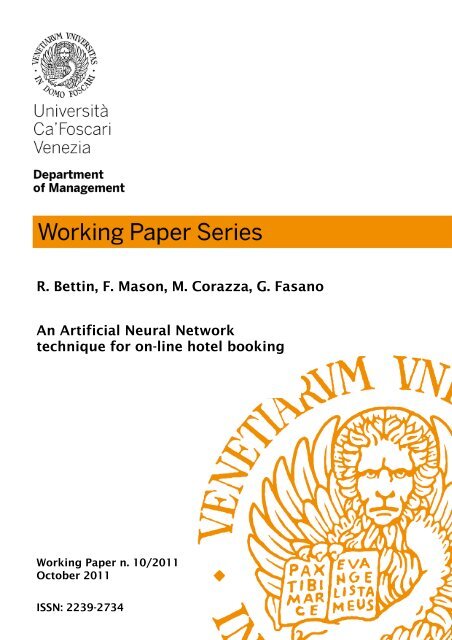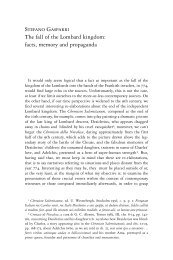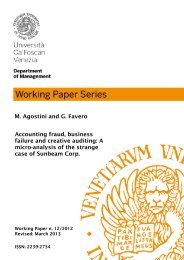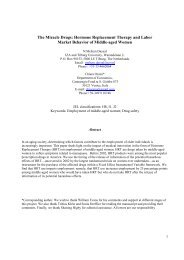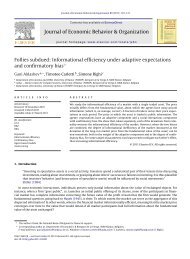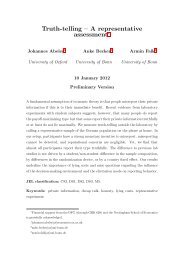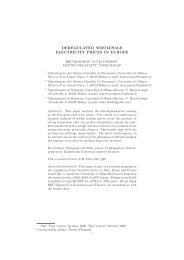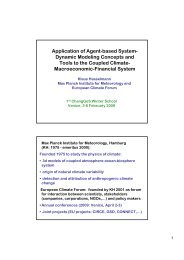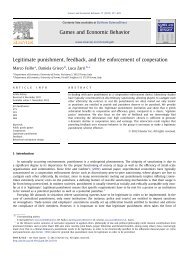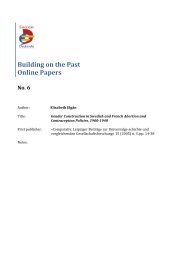R. Bettin, F. Mason, M. Corazza, G. Fasano An ... - Università Ca
R. Bettin, F. Mason, M. Corazza, G. Fasano An ... - Università Ca
R. Bettin, F. Mason, M. Corazza, G. Fasano An ... - Università Ca
Create successful ePaper yourself
Turn your PDF publications into a flip-book with our unique Google optimized e-Paper software.
R. <strong>Bettin</strong>, F. <strong>Mason</strong>, M. <strong>Corazza</strong>, G. <strong>Fasano</strong><br />
<strong>An</strong> Artificial Neural Network<br />
technique for on-line hotel booking<br />
Working Paper n. 10/2011<br />
October 2011<br />
ISSN: 2239-2734
This Working Paper is published ! under the auspices of the Department of<br />
Management at <strong>Università</strong> <strong>Ca</strong>’ Foscari Venezia. Opinions expressed herein are those<br />
of the authors and not those of the Department or the University. The Working Paper<br />
series is designed to divulge preliminary or incomplete work, circulated to favour<br />
discussion and comments. Citation of this paper should consider its provisional<br />
nature.
<strong>An</strong> Artificial Neural Network-based technique<br />
for on-line hotel booking ∗<br />
Renato <strong>Bettin</strong> Francesco <strong>Mason</strong><br />
<br />
SG Application & Consulting Department of Management<br />
Microsoft Certified Professional & <strong>Ca</strong>’ Foscari University of Venice<br />
Microsoft Certified Technology Specialist<br />
Marco <strong>Corazza</strong> Giovanni <strong>Fasano</strong><br />
<br />
Department of Economics Department of Management<br />
Advanced School of Economics in Venice <strong>Ca</strong>’ Foscari University of Venice<br />
<strong>Ca</strong>’ Foscari University of Venice INSEAN-CNR Italian Ship Model Basin<br />
(October 2011)<br />
Abstract. In this paper the use of Artificial Neural Networks (ANNs) in on-line booking<br />
for hotel industry is investigated. The paper details the description, the modeling and the<br />
resolution technique of on-line booking. The latter problem is modeled using the paradigms<br />
of machine learning, in place of standard ‘If-Then-Else’ chains of conditional rules. In<br />
particular, a supervised three layers MLP neural network is adopted, which is trained using<br />
information from previous customers’ reservations. Performance of our ANN is analyzed:<br />
it behaves in a quite satisfactory way in managing the (simulated) booking service in a<br />
hotel. The customer requires single or double rooms, while the system gives as a reply the<br />
confirmation of the required services, if available. Moreover, we highlight that using our<br />
approach the system proposes alternative accommodations (from two days in advance to<br />
two days later with respect to the requested day), in the case rooms or services are not at<br />
disposal. Numerical results are given, where the effectiveness of the proposed approach is<br />
critically analyzed. Finally, we outline guidelines for future research.<br />
Keywords: On-line booking, hotel reservation, machine learning, supervised multilayer<br />
perceptron networks.<br />
JEL Classification Numbers: C80, C63.<br />
Correspondence to:<br />
Francesco <strong>Mason</strong> Dipartimento di Management, <strong>Università</strong> <strong>Ca</strong>’ Foscari Venezia<br />
San Giobbe, <strong>Ca</strong>nnaregio 873<br />
30121 Venezia, Italy<br />
Phone: [+39] 041-234-6916<br />
Fax: [+39] 041-234-7444<br />
E-mail: fmason@unive.it<br />
∗ M.<strong>Corazza</strong> thanks the Advanced School of Economics in Venice for the support received. G.<strong>Fasano</strong><br />
thanks the INSEAN - CNR, Italian Ship Model Basin for the support received.
1 Introduction<br />
Aim of this paper is to present some results about the use of Artificial Neural Networks<br />
(ANNs), as automatic tools for the management of on-line booking of hotels. In particular,<br />
our objective is to analyze at what extent some classes of ANNs (namely supervised<br />
Multilayer Perceptron networks) can help - in the limit case can replace - employees of<br />
booking offices in hotels, in order to manage the operations of on-line booking of rooms<br />
and services. This is a very challenging aspect of the use of sophisticated computer science<br />
tools in tourism industry. We will show that our proposal may be at least a support system<br />
to decision makers, who can directly gain advantage of the ANNs framework we analyze,<br />
using a reasonable amount of computational resources.<br />
The problem we focus on regards the analysis, the implementation and the training of<br />
an ANN, which is able to “learn” from past data (collected by customers), and which can<br />
provide information for new customers’ booking. In particular, we want to assess a tool<br />
with the capability of offering a set of services and facilities. Furthermore, we claim that<br />
our proposal can often represent a reliable support, which requires neither too long training<br />
time nor expensive devices to work.<br />
In this paper we also present extensive numerical experiences, as well as the motivations<br />
behind them, showing that the tool we propose appears often of interest. However, as<br />
expected, some limits of our tool may arise, regarding its performance: we will detail the<br />
latter and warn the readers about the harmful or uncritical application of our proposal.<br />
The paper is organized as follows. In the first section we describe some relevant aspects<br />
and remarkable issues of on-line booking. We describe how the latter aspects can be properly<br />
taken into account, in order to support the solution of the on-line booking problem for hotels.<br />
Then, in Section 3 some basic elements of machine learning and supervised multilayer<br />
networks are given. Finally, in Section 4 the numerical experiments we have carried out are<br />
illustrated, as well as the final results we obtained.<br />
2 Basics on on-line booking for hotel industry<br />
In last two decades, the development of computer science tools, including software, hardware<br />
and information exchange paradigms, yielded two synergic phenomena for our purposes.<br />
Namely, the increasing computational power, as well as the increasing capacity of data<br />
storing, and the rise of the WEB as an environment in which market operators may freely<br />
interact.<br />
On the other hand, Information Security allows firms to focus on fast interactive management<br />
of market relationships. The firms can indeed use information technology with the<br />
purpose to behave on the market in an active fashion, managing directly communication,<br />
proposals, contracts which were left beforehand in the range of each agent’s job.<br />
The WEB is now a keyword in the business horizon of the firms. Of course, this implies<br />
that several problems may arise, in order to handle the interactions of firms accessing the<br />
WEB. As a consequence, many services and WEB facilities have increased their importance,<br />
and have been charged with the burden of managing the on-line market. Among them, CRM<br />
(Customer Relationship Management) has the significant role of providing WEB instruments<br />
for the firms, having in mind their specific claims and objectives.<br />
Broadly speaking, in the research area of tools for the WEB, which are oriented to ease<br />
and to customize the interaction between the firms and the on-line market, we basically<br />
1
identify two renowned approaches. On one hand we have non-interactive instruments,<br />
mainly devoted to information and advertising of the proposals of each firm. On the other<br />
hand, more complex tools which can yield a stronger interaction among partners are widely<br />
spreading. The latter tools are pretty often useful to finalize the interaction towards a<br />
service delivery or a sale.<br />
In any case, the WEB spurs competitors to use and share simple and appealing interfaces:<br />
this implies that the WEB must be suited both to customers necessities and to<br />
the needs of the firms. Each interface must guarantee bidirectional and clear information<br />
exchange and spreading, allowing several different operations; e.g. qualification, communication,<br />
confirmation of an order, as well as modification or cancelation of it. The latter<br />
considerations inevitably apply to on-line traders and tour operators.<br />
In the hotel industry, the new possibilities introduced above are much relevant. Similarly<br />
to CRM for hotel industry, we have two prevalent approaches in the literature of on-line<br />
hotel booking. We have, on one hand, instruments which simply focus on advertising the<br />
hotel characteristics on the WEB. On the other hand, there are more specific instruments<br />
devoted to the on-line booking, where “booking” is intended as including the whole service<br />
and policies offered by the hotel to the customers, including specific reservation facilities of<br />
each hotel. The tools offered by the WEB in the second approach are undoubtedly more<br />
complete and sophisticated: this is because nowadays every hotel tends to provide a variety<br />
of services to customers, which are usually not limited to the simple reservation. As a<br />
consequence, on-line booking has to deal with strategic instruments, in order to pursue two<br />
relevant aspects of the on-line market: customer loyalty and customer take over. Thus,<br />
the software used to support customers booking must be also a “guide”, in order to route<br />
customer’s preferences since the early phase in which he/she states his/her own preliminary<br />
requirements or chooses services.<br />
Many factors contribute to the complexity of the resulting software. From an operational<br />
point of view, it must ensure robustness and continuity of the service, a multi-language<br />
environment and safety of transactions. On the other hand, articulated “Definition Paths”<br />
(DP) 1 are required, based on the characterization of the customer. This can be done through<br />
suitable on-line questions (posed to the customer) or through the analysis of the customers<br />
in the hotel data base (or in the data base of the hotel cluster). Indeed, the analysis of<br />
historical data may suggest some recursive preferences of customers, possibly related to the<br />
venue of the hotel. Then, the latter process of collecting data can yield the proposal of<br />
specific services, guiding the customer in the choice. Therefore, the ideal on-line tool which<br />
supports the user must progressively update its data base, paying a specific attention to<br />
reference both the preferences of customers and the offered services.<br />
In order to detail more accurately the DFs, observe that they are expected to include:<br />
∙ The time periods required for booking;<br />
∙ The final price list;<br />
∙ The characteristics of the customers, i.e. their nationality, social status, . . .;<br />
∙ The motivation of customers trip, i.e. business trip, holiday trip, . . .<br />
Moreover, to complete the on-line booking process started with a DP, the latter is usually<br />
followed by:<br />
1 We call “Definition Path” the set of questions we ask the customer, in order to carefully assess his/her<br />
booking preferences (location and services).<br />
2
∙ The communication of acceptance, or alternative proposals;<br />
∙ The specification of selected services.<br />
The specification of the selected services is often a non-trivial result, since services are<br />
most of the times interrelated. Thus, one service can imply or exclude another one, on the<br />
basis of rules system, which can be strongly structured. In a dynamic framework, due to the<br />
time window chosen by the customer or to some other factors, more complex situations can<br />
arise. For example, prices can significantly vary, following the seasonal trend, the number<br />
of free chambers, or the competition among hotels. In addition, also cultural events can<br />
affect prices in a specific time period. To sum up, automatic procedures and instruments<br />
are definitely needed, which dynamically allow the interaction of customers and hotels, in<br />
a fast changing scenario.<br />
The building and the maintenance of DPs, within automatic procedures devoted to<br />
on-line booking, should consider the following two problems:<br />
∙ The software used can hardly manage all the If-Then-Else boolean rules which are<br />
necessary to build the DPs;<br />
∙ The difficulties to update the rules, as well as the introduction of new ones, claims for<br />
skilled and specialized operators, and represents a time-consuming operation.<br />
In turn, the costs of maintenance of the software for the on-line booking can often<br />
prohibitively increase. Moreover, difficulties may arise in order to respect deadlines. The<br />
investigation of how to overcome the latter drawbacks is among the objectives of this paper.<br />
3 Basics on machine learning<br />
In order to partially clarify the issue in the last paragraph of the previous section, we<br />
introduce here some preliminary concepts regarding Machine Learning, along with some<br />
of its possible applications. Machine learning involves procedures and techniques, which<br />
are naturally related to the capabilities of analysis and data processing of human beings.<br />
As a consequence, machine learning is also strictly related to adaptive behaviors. Indeed,<br />
daily experience suggests that all the living organisms interact with the environment, both<br />
exchanging information and adaptively modifying their reactions. The latter facts, not<br />
to mention the huge literature about the meaning of “intelligence”, indicates that a formal<br />
assessment of machine learning paradigms is mandatory, if technical achievements are<br />
sought.<br />
On this guideline, Artificial Neural Networks (ANNs), regardless of their specific approach,<br />
attempt to emulate the cognitive capabilities and processing models of developed<br />
individuals. In particular, neural networks are often based on a system of elementary entities<br />
and rules, whose main purpose is that of emulating the human brain paradigms. To<br />
our knowledge, the first theoretical results from emulating the elements of the human brain,<br />
are due to W.S. McCulloch and W.Pitts (1943), and F.Rosenblatt (1958-1960) [Bis95], who<br />
tried to model the basic behavior of the neurons. They also showed that modeling the<br />
neuron as the input/output function<br />
𝑦𝑖(𝑥𝑖) = 𝑠𝑔𝑛(𝑤 𝑇 𝑖 𝑥𝑖 − 𝜃𝑖), (1)<br />
3
where 𝑥𝑖 ∈ 𝐼𝑅 𝑛 is the input vector, 𝑤𝑖 ∈ 𝐼𝑅 𝑛 is a vector of weights, 𝜃𝑖 ∈ 𝐼𝑅 is a real<br />
threshold, then all the standard boolean functions (i.e. AND, OR, NOT, NAND, NOR)<br />
may be modeled by combining a set of functions like (1), where the parameters 𝑤𝑖, 𝜃𝑖 are<br />
suitably chosen (see for instance [GS03, Hay99, Nov62] for the algorithm of perceptron).<br />
3.1 Paradigms of machine learning<br />
In this section we briefly describe guidelines for a taxonomy of models and methods of<br />
machine learning. To this purpose we represent the overall ANN as<br />
𝑦 = ℱ(𝑥), (2)<br />
where 𝑥 ∈ 𝐼𝑅 𝑛 is the input vector, 𝑦 ∈ 𝐼𝑅 𝑚 is the output vector and ℱ(⋅) contains a set of<br />
neurons like (1).<br />
The ANN will be trained when the parameters 𝑤𝑖 and 𝜃𝑖 are assessed, according with<br />
the learning mechanism chosen. Observe that in general the function 𝑠𝑔𝑛(⋅) in (1) may be<br />
replaced by several other functions (e.g. the Heavyside function, the sigmoidal function,<br />
etc.), which are usually addressed as the activation functions of the neuron. The latter<br />
fact yields different properties of the overall resulting ANN [Hay99]. Basically, the learning<br />
processes used to set the parameters 𝑤𝑖 and 𝜃𝑖 of each neuron may be classified as follows:<br />
∙ supervised learning: where the ANN (2) is trained using ex ante a sequence of<br />
ordered input/output pairs, indicated as {(𝑥ℓ, 𝑦ℓ)};<br />
∙ unsupervised learning: where the ANN (2) is trained using ex ante only a sequence<br />
of inputs, indicated as {𝑥ℓ}.<br />
The first learning paradigm is often addressed as learning by teacher (like students who<br />
learn each 𝑥ℓ and are corrected by the teacher who suggests 𝑦ℓ). Also observe that supervised<br />
learning is strongly advisable when {𝑥ℓ} and {𝑦ℓ} are both available. <strong>An</strong>other important<br />
learning classification for ANNs is given by<br />
∙ batch learning: where the sequences {(𝑥ℓ, 𝑦ℓ)} or {𝑥ℓ} are entirely provided before<br />
the learning process starts;<br />
∙ online learning: where the data (𝑥1, 𝑦1), (𝑥2, 𝑦2), . . . or 𝑥1, 𝑥2, . . . are progressively<br />
(i.e. online) provided during the learning process.<br />
When the data for learning are all available and are not too many (with respect to the<br />
storage or the computation involved by the learning process), then batch learning should<br />
be preferable (it will be indeed our choice as described in Section 4.2).<br />
On the other hand, the architecture of the ANNs may of course strongly affect the<br />
learning process. In particular, since ℱ(⋅) is a collection of connected neurons we can assess<br />
the ANN after choosing<br />
1. the nature of neurons (for instance using the form (1)), which can be<br />
∙ static: if the input/output relation of each neuron does not depend on time,<br />
∙ dynamic: if the input/output relation of each neuron does depend on time,<br />
2. the inner parameters of the neurons and the parameters associated with the connections<br />
among the neurons,<br />
4
3. the architecture of the ANN (e.g. double-layer, multilayer, etc.).<br />
Finally, it is worth mentioning that in an ANN the output of the network may be suitably<br />
recombined with the input, in order to give more generality to the learning process. This<br />
implies that if the ANN is represented by a graph, where the neurons are the nodes and<br />
the connections among them are the arcs, we can distinguish between<br />
a) feedforward ANN: represented by an acyclic graph,<br />
b) feedback ANN: represented by a graph containing cycles.<br />
The taxonomy in this section is necessary in order to motivate our choice to consider<br />
a specific ANN, to solve our online-booking problem for hotels, described in Section 4.1.<br />
Thus, observe that all the data for training are available from previous online-booking of<br />
customers, and can be stored. Moreover, considering that we are concerned with a single<br />
period analysis, we are going to use in Section 4.2 a multilayer feedback ANN (see also<br />
[LLPS93]), which is trained by a supervised learning process. In the next section we specify<br />
the two main purposes that our ANN is asked to pursue: the latter will further motivate<br />
our choice for a multilayer feedback ANN, trained by a supervised process.<br />
3.2 Practical use of ANNs<br />
ANNs are commonly designed to automatically solve some categories of practical problems,<br />
using the data related to those problems. We briefly summarize here three relevant classes<br />
of problems whose solution often involves ANNs.<br />
Pattern Recognition, where the training data are suitably classified into classes, so<br />
that possible new data will be assigned to the correct classes [Bis95, Bur98] (several problems<br />
of data clustering belong to the latter category).<br />
Function Approximation. Suppose the set 𝐼 = {(𝑥𝑖, 𝑦𝑖) : 𝑥𝑖 ∈ 𝐼𝑅 𝑛 , 𝑦𝑖 ∈ 𝐼𝑅 𝑚 , 𝑖 =<br />
1, . . . , 𝑁} is given, and there exists the function 𝑦 = 𝑓(𝑥) such that the following interpolation<br />
conditions hold<br />
𝑦𝑖 = 𝑓(𝑥𝑖), 𝑖 = 1, . . . , 𝑁. (3)<br />
We want to build the ANN 𝑦 = ℱ(𝑥) such that for a given 𝜀 > 0<br />
∥𝑓(𝑥) − ℱ(𝑥)∥∗ < 𝜀, ∀𝑥 ∈ 𝐼𝑅 𝑛 , (4)<br />
i.e. the ANN 𝑦 = ℱ(𝑥) should be an approximation of 𝑓(𝑥) over 𝐼𝑅 𝑛 , in the sense specified<br />
by the norm ∥ ⋅ ∥∗. Of course, the function approximation problem (4) admits in general<br />
more than one solution, and may be naturally tackled using a supervised approach (see also<br />
[PG90]).<br />
Regression problem. Given the set 𝐼 = {(𝑥𝑖, 𝑦𝑖) : 𝑥𝑖 ∈ 𝐼𝑅 𝑛 , 𝑦𝑖 ∈ 𝐼𝑅 𝑚 , 𝑖 = 1, . . . , 𝑁},<br />
we want to build the ANN 𝐹 : 𝑊 × 𝐼𝑅 𝑛 → 𝐼𝑅 𝑚 such that 𝑦 = 𝐹 (𝑤, 𝑥), where 𝑊 is a set of<br />
possible parameters. Unlike the case of function approximation, here we want to find the<br />
set of parameters ¯𝑤 such that 𝐹 ( ¯𝑤, 𝑥) is the regression function<br />
𝐹 ( ¯𝑤, 𝑥) =<br />
∫ +∞<br />
−∞<br />
𝑦 ⋅ 𝑝 𝑌/𝑋(𝑦/𝑥)𝑑𝑦,<br />
where 𝑝 𝑌/𝑋(𝑦/𝑥) is the conditional probability density function of variable 𝑌 given 𝑋,<br />
associated with the set 𝐼. As well known [Vap98, Vap98], 𝐹 ( ¯𝑤, 𝑥) solves<br />
min<br />
𝑤<br />
∫ +∞ ∫ +∞<br />
−∞<br />
−∞<br />
⋅[𝑦 − 𝐹 (𝑤, 𝑥)] 2 𝑝𝑋,𝑌 (𝑥, 𝑦)𝑑𝑥𝑑𝑦<br />
5
and in general 𝑝𝑋,𝑌 (𝑥, 𝑦) is not a priori known. As a consequence of the classification above,<br />
the training of an ANN, i.e. the assessment of its parameters, must agree with one of the<br />
three categories in this section.<br />
Moreover, note that the ANN 𝐹 (𝑥) which satisfies (4), in general does not satisfy the interpolation<br />
condition (3). The latter issue is much relevant for the ANNs we will adopt, and<br />
as showed in Section 4.2, it strongly affects both the training process and the effectiveness<br />
of the final ANN.<br />
We complete this section with a brief consideration on the complexity of ANNs. On<br />
this purpose, for the sake of completeness we should analyze the essential concept of VCdimension<br />
(Vapnik-Cervonenkis-dimension) for ANNs. However, the latter concept is not<br />
among the main issues of this paper (see [Vap98, Hay99] for an extensive description), thus<br />
we simply report that the VC-dimension of an ANN is a measure of the capability of that<br />
ANN to discriminate among the pairs (𝑥𝑖, 𝑦𝑖) of input/output in the set 𝐼. Intuitively<br />
speaking, this means that a larger number of data will in general require a more complex<br />
structure of the ANN, i.e. a network where a larger number of parameters (degrees of<br />
freedom) 𝑤 must be included. Thus, it is possible to assess in general the VC-dimension<br />
of each ANN in terms of the number of parameters of the ANN. On this guideline we have<br />
the following result [Hay99], which gives an indication in order to set the architecture of an<br />
ANN.<br />
Proposition 3.1 Let 𝐹 (𝑤, 𝑥) be an ANN, where 𝑤, 𝑥 ∈ 𝐼𝑅 𝑛 and 𝑤 is a vector of parameters.<br />
Suppose 𝐹 (𝑤, 𝑥) is built using neurons like (1). Then, the VC-dimension of 𝐹 (𝑤, 𝑥)<br />
is 𝑂(𝑛 log 𝑛).<br />
3.3 The Multi-Layer Perceptron (MLP) ANNs we used<br />
Multilayer ANNs use the functional expression (1) (or similar) of the neurons, and are organized<br />
as a sequence of layers (see Figure 1). The latter figure sketches the basic structure<br />
of a feedforward MLP as a graph, where the neurons are the nodes (circles) and the connections<br />
among neurons are the arcs. Now we briefly describe the latter structure and the<br />
problems involved in training an MLP.<br />
As evident from Figure 1 an MLP is organized into layers, each including a number<br />
of neurons, so that a more complex MLP will possibly contain a larger number of layers<br />
and/or a larger number of neurons each layer. Also observe that the standard architecture<br />
of an MLP requires that if the node 𝑣𝑖 is connected with the node 𝑣𝑗, then 𝑣𝑖 and 𝑣𝑗 must<br />
belong to different layers. Moreover, in an MLP with 𝐿 layers the input and output layers<br />
have a special structure. Indeed, the threshold 𝜃 in the neurons of the input layer is zero,<br />
while the output of the neurons in the output layer (i.e. the 𝐿-th layer) coincides with the<br />
output of the MLP. As regards the Figure 1, the following comments hold:<br />
∙ Between the 𝑖-th neuron in the (𝑘 − 1)-th layer and the 𝑗-th neuron in the 𝑘-th layer<br />
∈ 𝐼𝑅;<br />
there is an arc, with the associated weight 𝑤 (𝑘)<br />
𝑗𝑖<br />
∙ At the 𝑗-th neuron in the 𝑘-th layer we associate the activation function 𝑔 (𝑘)<br />
𝑗 (⋅), such<br />
that<br />
𝑧 (𝑘)<br />
𝑗<br />
(<br />
= 𝑔(𝑘)<br />
𝑗<br />
6<br />
𝑎 (𝑘)<br />
𝑗<br />
)<br />
,
Figure 1: The structure of a supervised MLP network.<br />
Figure 2: The meaning of the expression 𝑎 (𝑘)<br />
𝑗<br />
7<br />
= −𝑤(𝑘)<br />
𝑗0 + ∑ 𝑛 (𝑘−1)<br />
𝑖=1<br />
𝑤(𝑘)<br />
𝑗𝑖 𝑧(𝑘−1)<br />
𝑖<br />
.
where<br />
𝑤 (𝑘)<br />
𝑗0<br />
𝑎 (𝑘)<br />
𝑗<br />
= −𝑤(𝑘)<br />
𝑗0 +<br />
𝑛 (𝑘−1)<br />
∑<br />
𝑖=1<br />
𝑤 (𝑘)<br />
𝑗𝑖 𝑧(𝑘−1)<br />
𝑖<br />
is the threshold of the 𝑗-th neuron in the 𝑘-th layer, 𝑧(𝑘)<br />
𝑗 is the output of the 𝑗-th<br />
neuron in the 𝑘-th layer, and 𝑛 (𝑘−1) is the number of neurons in the (𝑘 − 1)-th layer<br />
(see also Figure 2).<br />
For the sake of clarity we report that using the MLP 𝐹 (𝑤, 𝑥), with just two layers,<br />
if the activation function 𝑔(⋅) is not a polynomial, then any continuous function ℎ(𝑥),<br />
ℎ : 𝐼𝑅 𝑛 → 𝐼𝑅 𝑚 , can be approximated with 𝐹 (𝑤, 𝑥), over any compact set Ω ⊂ 𝐼𝑅 𝑛 . In other<br />
words, we have (see also [Pin96, PG90, BBIF85, Hay99])<br />
as detailed in the following sections.<br />
sup ∥ℎ(𝑥) − 𝐹 (𝑤, 𝑥)∥∗ < 𝜀, 𝜀 > 0,<br />
𝑥∈Ω<br />
4 Our case-study: presentation and numerical results<br />
In this section we first give an overview of our on-line hotel booking problem, then we<br />
describe the ANN-based approach we implemented in order to tackle this problem. Finally,<br />
we report the (hopefully satisfactory) results obtained by the application of our approach.<br />
4.1 Our on-line hotel booking problem<br />
The on-line hotel booking problem we studied can be briefly described using the following<br />
items.<br />
∙ We start by considering a given hotel characterized by a prefixed structure in terms<br />
of typology of rooms (for instance: single, double, . . .), number of rooms for each<br />
typology, other services (for instance: availability of meeting rooms, of car parking,<br />
. . . );<br />
∙ At current time 𝑡 a possible customer asks the hotel the current or future availability<br />
of some kind of services (for instance: a double room and a car parking at time 𝑡+5) 2 ;<br />
∙ At the same time 𝑡 an operator (typically a human one) checks for the availability of<br />
the requested service;<br />
∙ If such a service is satisfiable, then the operator gives a positive answer to the customer;<br />
otherwise the operator provides the customer with an alternative solution (for<br />
instance: two single rooms and a car parking at time 𝑡 + 5, a double room without a<br />
car parking at time 𝑡 + 4, . . .).<br />
The last item contains all the elements of difficulty of the problem we are dealing with.<br />
In fact, the following considerations hold.<br />
2 The unit measure of time we consider is the day.<br />
8<br />
,
∙ First, in order to provide an automatic answer to the customer’s request a suitable<br />
database is necessary (but a wide description of the latter issue goes beyond the<br />
purpose of this paper).<br />
∙ Second, if the request of the customer is satisfiable, then a solution has to be searched<br />
for by interrogating the database. Generally, this is an hard task, considering the<br />
combinatorial nature of the searching problem. In order to exemplify this point,<br />
let we consider the case one-single-room-and-a-car-parking for an hotel having 𝑠 free<br />
single rooms and 𝑝 free car parking: the number of possible solutions might be 𝑠 ⋅ 𝑝.<br />
∙ Third, if the request of the customer is not satisfiable, then one or more alternative<br />
solutions have to be searched for by interrogating the database. Generally, this is again<br />
an hard task given the combinatorial nature of the searching problem. In order to<br />
exemplify this point, it is enough to consider the case two-single-rooms-and-a-doubleone-instead-of-a-triple-room,<br />
for an hotel having 𝑠 free single rooms and 𝑑 free double<br />
rooms: the number of possible solutions should be 𝑠(𝑠 − 1)𝑑.<br />
Therefore, it is evident that, yet in case of small or medium hotel, a human operator<br />
or a standard automatized system should not be able to suitably interrogate the database<br />
in a commercially reasonable time, being this due to the intrinsic difficulty 3 of the search<br />
problem itself.<br />
Given these premises, the on-line hotel booking problem we have dealt with may be<br />
formulated as follows. Instead of performing a more or less refined searching algorithm<br />
(pursuing the fulfillment of customer’s requests by an If-Then-Else procedure), we can<br />
address a suitable function (if any) that receives as inputs the state of the hotel (for instance:<br />
the current number of free single/double rooms, the number of free single/double rooms<br />
tomorrow, . . .) along with the requests of the customer, and provides as output a solution<br />
(if any), or alternative solutions if the requests are not satisfiable.<br />
Obviously, the functional form (say 𝑓(𝑥)) of such a function and the value of its coefficients<br />
strongly depend on the hotel structure. So, a priori the latter function may be<br />
not easily specifiable. Because of that, we decided to use MLP ANNs as “inferential tool”,<br />
considering their capability to be universal approximators of unknown functions, mapping<br />
known input datasets into known output datasets. Of course other choices could be considered,<br />
e.g. the Radial Basis Functions (RBFs) may have represented fruitful alternative<br />
supervised ANNs.<br />
4.2 The MLP ANN-based approach<br />
Ad detailed in the previous section, the performances of an MLP ANN may be strongly affected<br />
by its architectural structure (typically: the number of hidden layers and the number<br />
of artificial neurons for each of these layers) and by the considered learning algorithm. In<br />
its turn, the choice of the architectural structure and the learning algorithm depend on the<br />
pursued targets. Recalling what was reported in Section 3.2, with regard to the practical<br />
uses of ANNs, we may consider to build our ANN pursuing two mutually exclusive targets:<br />
3 Observe that if the customer has 𝑚 specific requests, each request 𝑅𝑖, 𝑖 = 1, . . . , 𝑚, can be TRUE/FALSE<br />
depending on the fact that it can be satisfied or not. Thus, the overall request of the customer reduces to a<br />
satisfiability problem (known in the literature as the propositional logic problem SAT), which is NP-complete<br />
[GJ79], i.e. it cannot be solved in a polynomial computational time with the input string.<br />
9
∙ approximating the searched for function 𝑦 = 𝑓(𝑥) by means of a suitable ANN (say<br />
𝑦 = ℱ(𝑥))<br />
∙ applying regression to the searched for function 𝑦 = 𝑓(𝑥), yielding the appropriate<br />
function 𝑦 = 𝐹 (𝑤, 𝑥).<br />
Roughly speaking, the main difference between the two approaches consists in the following<br />
fact. With ‘function approximation’ here we mean that ℱ(𝑥) has to exploit the<br />
generalization capabilities of ANNs (therefore, ℱ(𝑥) is expected to be substantially based<br />
on small- or medium-sized MLPs) 4 . On the other hand, with ‘function regression’ here<br />
we mean that 𝐹 (𝑤, 𝑥) mainly attempts to consider the interpolation properties of ANNs<br />
(therefore, 𝐹 (𝑤, 𝑥) is expected to be essentially based on medium- and large-sized MLPs).<br />
4.3 Numerical results<br />
The first necessary step to implement any supervised MLP ANN consists in building a<br />
suitable dataset, collecting both the inputs and the outputs into pairs. Furthermore, in<br />
order to assure our experimentation as reliability as possible, we need possibly a large<br />
dataset. So, in accordance with the indication of north-eastern Italian tourism experts, we<br />
randomly generated a significant database of simulated pairs (𝑥𝑖, 𝑦𝑖), with 𝑖 = 1, . . . , 50000,<br />
where 𝑥𝑖 ∈ 𝐼𝑅 𝑛 represents the 𝑖-th vector of the inputs and 𝑦𝑖 ∈ 𝐼𝑅 𝑚 represents the 𝑖-th<br />
vector of the outputs.<br />
As far as the input vector structure is concerned, each input vector 𝑥𝑖 contains information<br />
regarding:<br />
∙ The request of the customer, namely: the availability of some kind of services in 𝑡+Δ𝑡,<br />
with Δ𝑡 = 0, 1, . . ., and the number of days in advance, with respect to 𝑡 + Δ𝑡, this<br />
request has been received by the hotel;<br />
∙ The state of the hotel as described in Section 4.1. In particular, we have taken<br />
into account an hypothetical small-medium sized hotel having only single and double<br />
rooms; further, in case the customer’s request is not satisfiable, alternative solutions<br />
(if any) are provided, for at most two days before 𝑡 + Δ𝑡 and two days after 𝑡 + Δ𝑡.<br />
Therefore, on the overall 𝑛 = 13 entries of the input vector have been used.<br />
As far as the input vector structure is concerned, in order to avoid as much as possible<br />
the well known “curse of dimensionality” phenomenon (see for instance [Bis95]), we decided<br />
to use an univariate discrete output. In particular, the output takes values in the set<br />
{0, 1000, 2000, . . . , 7000, 8000, 9000},<br />
depending on the fact that the customer’s request is satisfiable (𝑦 = 0), the customer’s<br />
request is not satisfiable but an alternative solution exists in 𝑡 + Δ𝑡 − 1 (𝑦 = 1000) or exists<br />
in 𝑡 + Δ𝑡 + 1 (𝑦 = 2000) and so on, up to ‘no alternative solutions exist’ (𝑦 = 9000). Notice<br />
that the output values are so spread in order to facilitate the learning 5 .<br />
At this point, as stated above, we have randomly generated 50000 significant simulated<br />
pairs (𝑥𝑖, 𝑦𝑖). However, after a careful glance of this dataset, it appears that the pairs<br />
4<br />
The adjective “sized” is referred both to the number of hidden layers and to the number of artificial<br />
neurons contained in each of these layers.<br />
5<br />
≪[I]n many practical applications the choice of pre-processing will be one of the most significant factors<br />
in determining the performance of the final system≫ (see [Bis95] at page 295).<br />
10
are not uniformly distributed with respect to the output value (see Table 1). This is an<br />
indirect confirmation of the complex nature of the on-line hotel booking problem we have<br />
considered. Of course, such a non-uniform distribution could make the supervised learning<br />
process of our ANN (particularly) difficult, since some output values are not as frequent as<br />
others.<br />
Output values 0 1000 2000 3000 4000 5000 6000 7000 8000 9000<br />
Pair percentages 19.60% 3.52% 3.37% 5.75% 1.51% 3.37% 5.24% 3.91% 7.89% 45.81%<br />
Table 1: Percentage distribution of the pairs with respect to the output value.<br />
As premised in Section 4.2, the second step we dealt with was the implementation<br />
of small/medium sized ANN MLPs, in order to approximate the searched for unknown<br />
function. The guidelines we essentially followed for the design of these ANN MLPs were:<br />
∙ The use of one or two – and no more – hidden layers. As known, an MLP with<br />
an hidden layer is able to linearly separate the output space, and an MLP with two<br />
hidden layers is in principle able to non-linearly separate the same space;<br />
∙ The use of a low number of artificial neurons for each of the considered hidden layer(s);<br />
∙ The use of standard sigmoid squashing function for the artificial neurons belonging<br />
to the hidden layer(s), and the use of the linear squashing function for the output<br />
artificial neuron;<br />
∙ The use of standard learning algorithms of Error Back Propagation (EBP) type like,<br />
for instance, the Levenberg-Marquardt EBP one or the scaled conjugate gradient EBP<br />
one.<br />
As far as the learning phase is concerned:<br />
∙ For each of the considered MLP ANNs we used a subset of 40000 pairs (𝑥𝑖, 𝑦𝑖) (always<br />
the same) of the 50000 pairs randomly generated, in order to train the MLP ANNs.<br />
Then, once the learning was complete, we used the subset of the remaining 10000<br />
pairs to check the performances of each trained MLP ANN. Notice that these subsets,<br />
respectively known as “training set” and “testing set”, are built in such a way that<br />
they both respect the percentage distribution in Table 1. This allows the comparison<br />
of the performances of a given MLP ANN, outreached during the training phase, with<br />
the performances of the same MLP ANN reached during the validation phase;<br />
∙ Likely, the most widespread rules for learning stopping are the ones which arrest<br />
the learning process after a prefixed number of epochs 6 , and the ones which stop the<br />
learning at the epoch in which the MLP ANN commits an error 7 lower than a prefixed<br />
threshold. In our approach we considered a stopping learning rule given by a mixing<br />
of the ones just described. Indeed, we do not stop the learning process<br />
6 In the ANN jargon, the term “epoch” means an iteration of the iterative training phase, during which<br />
all the input-output pairs belonging to the training set are used to train the MLP ANN.<br />
7 Usually, the error is expressed in terms of Mean Square Error (MSE) calculated between the true output<br />
values and the output values estimated by the ANN.<br />
11
until the number of epochs is lower or equal than a prefixed value<br />
AND<br />
until the error committed by the ANN MLP is greater than a prefixed threshold.<br />
In particular, we used different values for the maximum number of epochs, and we<br />
used the value 10 −6 for the error threshold.<br />
In terms of the results, most of the different architectures adopted for our MLP ANNs<br />
have performed in quite similar ways, none of them being fully satisfactory (with respect<br />
to the others). In Table 2 we report some results obtained by using one of the most<br />
outstripping of such MLP ANNs, the one characterized by: 2 hidden layers; 25 artificial<br />
neurons in the first hidden layer and 10 artificial neurons in the second hidden layer; the<br />
scaled conjugate gradient EBP learning algorithm. Further, we considered the following<br />
values for the maximum number of epochs: 5000, 15000, 75000 and 250000 respectively.<br />
As far as the notation used in Table 2 is concerned: “%training” indicates the number<br />
of pairs (𝑥𝑖, 𝑦𝑖) belonging to the training set adopted; “%validation” indicates the number<br />
of pairs (𝑥𝑖, 𝑦𝑖) belonging to the validation set used; “%𝑖”, with 𝑖 ∈ {0, 1000, 2000, . . . , 7000,<br />
8000, 9000}, indicates the number of pairs (𝑥𝑖, 𝑦𝑖) belonging to the validation set having<br />
output value equal to 𝑖, which have been correctly recognized once the learning process is<br />
completed. Notice that:<br />
∙ Only for a large number of epochs, 250000 in the presented results, the considered MLP<br />
ANNs seem to learn, in fact %training = 73.367% and %validation = 71.474%. In<br />
any case, with particular reference to the performances obtained during the validation<br />
phase, although the results are appreciable from a research standpoint, they might<br />
not be usable for commercial purposes (a failure rate of about 30% may be still<br />
unacceptable);<br />
∙ As usual in MLP ANNs applications, the performances obtained during the training<br />
phase are better than the ones obtained during the validation phase in all the tests,<br />
although the discrepancy is not so evident;<br />
∙ As conjectured above, the non uniform distribution od the pairs with respect to the<br />
output values makes the learning process more difficult, in correspondence of the less<br />
frequent output values; as a case in point, for each test compare the value of %4000<br />
(4000 is the least frequent output value) with the value of %9000 (9000 is the most<br />
frequent output value).<br />
The third and last step we faced was, as premised in Section 4.2, the implementation<br />
of medium/large-sized MLP ANNs, in order to apply a form of regression (instead of approximation)<br />
to the searched for unknown function. The guidelines we followed during the<br />
design of the latter MLP ANNs were substantially the same used for the design of the<br />
small/medium-sized MLP ANNs. However, the following differences were considered:<br />
∙ The use of two or three – and no less – hidden layers;<br />
∙ The use of an higher number of artificial neurons for each of the considered hidden<br />
layers.<br />
12
Item Test 1 Test 2 Test 3 Test 4<br />
Number of epochs 5000 15000 75000 250000<br />
%training 36.245% 28.578% 47.395% 73.367%<br />
%validation 36.107% 28.036% 46.899% 71.474%<br />
%0 20.274% 8.537% 25.600% 66.413%<br />
%1000 16.000% 11.733% 20.253% 41.600%<br />
%2000 26.582% 29.114% 24.829% 37.658%<br />
%3000 30.993% 32.534% 18.440% 50.514%<br />
%4000 15.603% 19.149% 14.201% 33.333%<br />
%5000 14.201% 25.444% 20.038% 34.024%<br />
%6000 25.000% 22.710% 33.333% 55.916%<br />
%7000 31.129% 24.518% 50.713% 52.066%<br />
%8000 30.760% 24.822% 68.331% 55.463%<br />
%9000 50.869% 39.125% 81.133% 91.445%<br />
Table 2: Results related to a small/medium-sized ANN MLP.<br />
Also as far as the learning phase is concerned, we essentially adopted the settings used<br />
in the case of the small/medium-sized MLP ANNs. In term of the results, even now all the<br />
variously configured MLP ANNs have performed in quite similar ways, but unlike in the case<br />
of the small/medium-sized ANN MLPs, all of resulting configurations are quite satisfactory.<br />
In Table 3 we report some results obtained by one of our on-average-performing MLP ANN.<br />
The features of the MLP ANN detailed are summarized as follows: 2 hidden layers; 95<br />
artificial neurons in the first hidden layer and 76 artificial neurons in the second hidden<br />
layer; the scaled conjugate gradient EBP learning algorithm. Further, we considered the<br />
following values for the maximum number of epochs: 1250, 2500, 5000 and 7500 respectively.<br />
Observe that:<br />
∙ Even with a small number of epochs, 7500 in the presented results, the training process<br />
for the considered MLP ANNs seems satisfactory; in fact, %training = 98.818% and<br />
%validation = 97.900%. Furthermore, observe the close-to-100% values of %𝑖, with<br />
𝑖 ∈ {0, 1000, 2000, . . . ,<br />
7000, 8000, 9000}. With particular reference to the performances obtained during<br />
the validation phase, the results are fully appreciable from a research standpoint and<br />
surely usable for commercial purposes, as several north-eastern Italian tourism experts<br />
confirmed;<br />
∙ As usual in MLP ANNs applications, and as in the case of the small/medium-sized<br />
MLP ANNs, the performances obtained during the training phase are better than the<br />
ones obtained during the validation phase in all the test, although not in an evident<br />
way;<br />
∙ As conjectured above and as in the case of the small/medium-sized ANN MLPs, the<br />
non-uniform distribution of the pairs in the training set, with respect to the output<br />
value, makes the learning process more difficult in correspondence of less frequent<br />
output values.<br />
13
Item Test 1 Test 2 Test 3 Test 4<br />
Number of epochs 1250 2500 5000 7500<br />
%training 28.115% 45.233% 96.993% 98.818%<br />
%validation 27.646% 44.579% 95.939% 97.900%<br />
%0 1.067% 12.907% 94.461% 97.358%<br />
%1000 16.267% 36.267% 83.733% 91.733%<br />
%2000 46.835% 34.494% 86.076% 90.823%<br />
%3000 32.363% 26.712% 91.952% 92.980%<br />
%4000 17.021% 23.404% 67.376% 88.653%<br />
%5000 20.710% 26.036% 88.757% 95.858%<br />
%6000 40.458% 42.748% 97.137% 97.901%<br />
%7000 38.017% 46.281% 92.837% 97.521%<br />
%8000 43.112% 53.801% 98.931% 99.525%<br />
%9000 33.825% 62.371% 99.758% 99.934%<br />
Table 3: Results related with a medium/large-sized MLP ANN.<br />
5 Discussion and Conclusions<br />
We have proposed an alternative solution technique for an on-line-booking problem, from<br />
real applications. To the latter purpose we have used in particular MLP ANNs. The MPL<br />
ANNs we used show the strong influence, on the performance, of the number of layers and<br />
the number of nodes in the MLP. Moreover, considering the computational time needed<br />
for training and validate our different MLP ANNs, we can observe that in many cases they<br />
were noticeable high, using a commercial PC. However, we should consider that the training<br />
process of the ANNs is sbstantially an off-line process for hotel booking. Obviously, other<br />
experiences must be considered, in order to establish at what extent our proposal is effective<br />
in on-line booking. Hotel industry people would be glad to have instruments which manage<br />
different kinds of services: they wish also to ‘foresee’ and ‘anticipate’ customer’s preferences,<br />
in the sense that they wish to be able to offer services, such that the customer is not yet<br />
fully aware.<br />
14
References<br />
[Bis95] C.M.Bishop (1995) “Neural Networks for Pattern Recognition”, Oxford University<br />
Press, New York, USA.<br />
[BBIF85] Y.Borisovich, N.Bliznyakow, Y.Izrailevich, T.Fomenko (1985) “Introduction to<br />
Topology”, Mir Publishers, Moscow.<br />
[Bur98] C.J.C.Burges (1998) “A Tutorial on Support Vector Machines for Pattern Recognition”,<br />
Data Mining and Knowledge Discovery 2, pp. 121-167.<br />
[DW03] A.R.Dennis and M.L.Williams (2003) “Electronic Brainstorming: Theory, Research<br />
and Future Directions, in: Group Creativity, Paulus, P. (Ed.), Oxford University<br />
Press, Oxford.<br />
[GJ79] M.R.Garey and D.S.Johnson (1979) “Computers and Intractability: A Guide to<br />
the Theory of NP-Completeness (Series of Books in the Mathematical Sciences), Bell<br />
Telephone Laboratories, Incorporated.<br />
[GS03] L.Grippo, M.Sciandrone (2003) “Metodi di ottimizzazione per le reti neurali”, Rapporto<br />
Tecnico 09-03, <strong>Università</strong> di Roma “La Sapienza”, Dipartimento di Informatica<br />
e Sistemistica.<br />
[Hay99] S.Haykin (1999) “Neural Networks - A comprehensive foundation”, second edition,<br />
Prentice Hall International, New Jersey.<br />
[LLPS93] M.Leshno, V.Ya.Lin, A.Pinkus, S.Schocken (1993) “Multilayer feedforward networks<br />
with a non-polynomial activation function can approximate any function”, Neural<br />
Networks, vol. 6, pp. 861-867.<br />
[Nov62] A.B.J.Novikoff (1962) “On convergence proofs on perceptrons”, Proceedings of the<br />
Symposium on the Mathematical Theory of Automata, vol. XII, Polytechnic Institute<br />
of Brooklyn, pp. 615-622.<br />
[Pin96] A.Pinkus (1996) “TDI-Subspaces of 𝐶(𝐼𝑅 𝑑 ) and some Density Problems from Neural<br />
Networks”, Journal of Approximation Theory, vol. 85, pp.269-287.<br />
[PG90] T.Poggio, F.Girosi (1990) “Networks for approximation and learning”, Proceedings<br />
of the IEEE, vol. 78, pp. 1481-1497.<br />
[Vap98] V.N.Vapnik (1998) “Statistical Learning Theory”, John Wiley & Sons, Inc.<br />
[Vap98] V.N.Vapnik (2000) “The Nature of Statistical Learning Theory”, nella serie ‘Statistics<br />
for Engineering and Information Science’, Springer Verlag, Inc., Second Edition.<br />
15


